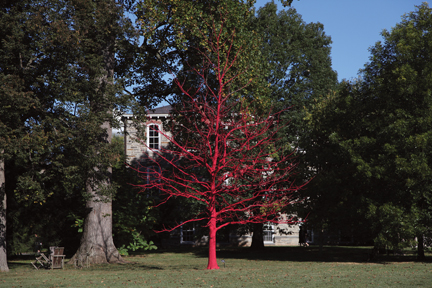Amuse, Excite, and Create Wonder
 A college campus that also houses an arboretum is expected to boast its fair share of colorful plants and trees, especially in the fall. An all-season, all-over red tree is a less likely sight. Particularly one with no leaves.
A college campus that also houses an arboretum is expected to boast its fair share of colorful plants and trees, especially in the fall. An all-season, all-over red tree is a less likely sight. Particularly one with no leaves.
The bright red tree is the most recent addition to a Scott Arboretum project that uses dead or dying trees as art objects. In 2006, a Chinese maackia tree suffocating from construction compaction was painted blue by an arboretum curatorial intern.
The current art tree is a dying 10-year-old bur oak (Quercus macrocarpa) suffering from physiological problems with its roots.
Rebecca Robert, coordinator for Arboretum members and visitors programs, says: “No matter the cause, as with similar ephemeral art projects, we saw this as an opportunity to draw attention to the loss of a tree and to amuse, excite, and create wonder in the community.”
Temple University design graduate Sam Keitch took two-and-a-half days to power–spray-paint the 30-foot-tree geranium red.
Standing on the lawn in front of Trotter Hall, the tree has been named In the Shadow of Abracadabra, appropriate to its location close to where, in fall 2000, artist Patrick Dougherty erected his twig sculpture Abracadabra on a dying Tilia americana.
Scott Arboretum Director Claire Sawyers says: “The motivation to do this is a sense of inexpensive ecologically oriented ephemeral art. It gets people to notice trees and think about their values in a different way—without taking living trees so much for granted, we hope. For little money and relatively little time, we get to appreciate (or mourn) the loss of a tree for a short period.”
Sawyers likes to turn a problem (i.e., a dead tree) into an opportunity (i.e., art). She mentions the Dougherty piece and artist Marty Long’s bender oak sculpture near the Faulkner Tennis Courts as similar but more costly experiments using outside artists, adding that the painted trees are in-house examples of the same philosophy.
“The blue tree lasted a year or two,” she says, “and in my 20 years here, it’s the only tree for which the students wrote an obituary, so it did seem to get their attention!”
 Email This Page
Email This Page
